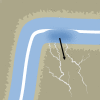Osteochondral defects in the ankle: why painful?
- PMID: 20151110
- PMCID: PMC2855020
- DOI: 10.1007/s00167-010-1064-x
Osteochondral defects in the ankle: why painful?
Abstract
Osteochondral defects of the ankle can either heal and remain asymptomatic or progress to deep ankle pain on weight bearing and formation of subchondral bone cysts. The development of a symptomatic OD depends on various factors, including the damage and insufficient repair of the subchondral bone plate. The ankle joint has a high congruency. During loading, compressed cartilage forces its water into the microfractured subchondral bone, leading to a localized high increased flow and pressure of fluid in the subchondral bone. This will result in local osteolysis and can explain the slow development of a subchondral cyst. The pain does not arise from the cartilage lesion, but is most probably caused by repetitive high fluid pressure during walking, which results in stimulation of the highly innervated subchondral bone underneath the cartilage defect. Understanding the natural history of osteochondral defects could lead to the development of strategies for preventing progressive joint damage.
Figures










Similar articles
-
The natural history of osteochondral lesions in the ankle.Instr Course Lect. 2010;59:375-86. Instr Course Lect. 2010. PMID: 20415393
-
Is retrograde drilling really useful for osteochondral lesion of talus with subchondral cyst?: A case report.Medicine (Baltimore). 2016 Dec;95(49):e5418. doi: 10.1097/MD.0000000000005418. Medicine (Baltimore). 2016. PMID: 27930520 Free PMC article.
-
Histomorphometric, CT arthrographic, and biomechanical mapping of the human ankle.Foot Ankle Int. 2013 Jul;34(7):1025-34. doi: 10.1177/1071100713477636. Epub 2013 Feb 8. Foot Ankle Int. 2013. PMID: 23396179
-
Articular cartilage. Anatomy, injury, and repair.Clin Podiatr Med Surg. 2001 Jan;18(1):35-53. Clin Podiatr Med Surg. 2001. PMID: 11344979 Review.
-
Management of Subchondral Lesions in the Foot and Ankle.Clin Podiatr Med Surg. 2023 Jul;40(3):553-568. doi: 10.1016/j.cpm.2023.03.005. Epub 2023 May 3. Clin Podiatr Med Surg. 2023. PMID: 37236691 Review.
Cited by
-
Biomechanical considerations in the pathogenesis of osteoarthritis of the elbow.Knee Surg Sports Traumatol Arthrosc. 2016 Jul;24(7):2313-8. doi: 10.1007/s00167-015-3518-7. Epub 2015 Feb 13. Knee Surg Sports Traumatol Arthrosc. 2016. PMID: 25677500 Free PMC article. Review.
-
Treatment of osteochondral defects of the talus in children.Knee Surg Sports Traumatol Arthrosc. 2014 Sep;22(9):2243-9. doi: 10.1007/s00167-013-2685-7. Epub 2013 Sep 18. Knee Surg Sports Traumatol Arthrosc. 2014. PMID: 24045918
-
Current concepts: tissue engineering and regenerative medicine applications in the ankle joint.J R Soc Interface. 2013 Dec 18;11(92):20130784. doi: 10.1098/rsif.2013.0784. Print 2014 Mar 6. J R Soc Interface. 2013. PMID: 24352667 Free PMC article. Review.
-
Outcomes of Bone Marrow Stimulation for Secondary Osteochondral Lesions of the Talus Equal Outcomes for Primary Lesions.Cartilage. 2021 Dec;13(1_suppl):1429S-1437S. doi: 10.1177/19476035211025816. Epub 2021 Jun 24. Cartilage. 2021. PMID: 34167358 Free PMC article.
-
Expression and related mechanisms of miR-330-3p and S100B in an animal model of cartilage injury.J Int Med Res. 2021 Sep;49(9):3000605211039471. doi: 10.1177/03000605211039471. J Int Med Res. 2021. PMID: 34590918 Free PMC article.
References
-
- Anderson DV, Lyne ED. Osteochondritis dissecans of the talus: case report on two family members. J Pediatr Orthop. 1984;4:356–357. - PubMed
-
- Berndt AL, Harty M. Transchondral fractures (osteochondritis dissecans) of the talus. J Bone Joint Surg Am. 1959;41-A:988–1020. - PubMed
-
- Braune W, Fischer O. Die Bewegungen des Kniegelenks nach einer neuen Methode am lebenden Menschen gemessen. Leipzig: S Hirzel; 1891. pp. 75–150.
MeSH terms
LinkOut - more resources
Full Text Sources
Other Literature Sources
Medical

